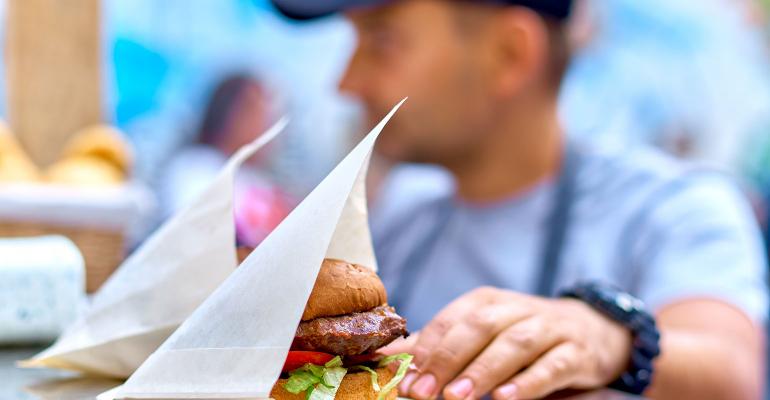Sponsored by Amazon Web Services
Tech-savvy chain restaurant operators have for some time been investing in Artificial Intelligence (AI), Machine Learning (ML) and the Cloud to predict how much food to order, to fill labor gaps, and to improve the overall customer experience. As these new technologies become an integral part of running a restaurant, a growing number of operators—large and small—are realizing that to be successful they need to follow suit.
According to a recent report, 60% of restaurant operators plan to implement some form of AI by 2025. Still, determining which technologies to use can be intimidating to less tech-oriented operators. Below are ways some forward-thinking chain operators have been successful using innovative technologies and how others can too.
Getting more personal
Knowing a customer’s name and remembering their last order or the way they take their coffee, is no longer a nice-to-have sign of good service—it’s a must-have. Operators can make relevant recommendations and improve customer experience with Machine Learning (ML), which enables computers to automatically learn from past data without explicit programming.
Before operators can get started with Machine Learning, they need to collect the data that accurate recommendations are built upon. Most restaurants have a slew of data sources – POS systems, loyalty program information, social feedback, external data, and much more – that resides in different systems. Integrating all of that data into a Cloud Data Lake is necessary to build robust, accurate Machine Learning models.
While operators do need access to quality data, they do not need a team of expert technologists to benefit from Machine Learning. For example, Domino’s Pizza Enterprises is having success using Amazon Personalize, which helps operators to improve customer experience without Machine Learning expertise.
“Using Amazon Personalize, we are able to achieve personalization at scale across our entire customer base, which was previously impossible. Amazon Personalize enables us to apply context about individual customers and their circumstances, and deliver customized communications such as special deals and offers through our digital channels." Allan Collins, Group Chief Marketing Officer - Domino's Pizza Enterprises.
Figuring out food forecasting
Consumers visiting or ordering online from a restaurant expect their favorite menu items will be available when and where they want them, and that they’ll be served, or delivered, hot and fresh. Yet, the ongoing supply chain disruptions and labor shortages are impacting availability of ingredients and other products make it nearly impossible for operators to fulfill those expectations.
Companies like Upserve, an online payment and analytical software provider to thousands of restaurants, are using Machine Learning to help restaurants predict their nightly business and meet peak demand.
“We can predict the total number of customers who will walk through a restaurant’s door in a night. As a result, restaurateurs can better prep and plan their staffing for that night,” says Bright Fulton, Upserve Director of Infrastructure Engineering.
Additionally, accurate forecasting has the power to reduce the amount of inventory needed on hand and ensure the right-sizing of stores as storage space for food and packaging materials is better planned and managed.
Under labor pressure
With seven out of 10 operators across all major segments reporting their restaurant currently does not have enough employees to support customer demand, technological solutions that ease labor pressures have become essential tools. And, with the U.S. Bureau of Labor Statistics reporting the quit rate among hospitality workers recently reached 6.8%, more than double the national average, the pressure isn’t going to ease anytime soon.
To tackle front-of-the-house labor demands, Margarita’s, a family-run Mexican restaurant, is using Cloud-based contact centers as a way to easily and affordably employ virtual agents anywhere to support their customers. After implementing Amazon Connect, a Cloud-based virtual call center, Margarita's reports that customer complaints decreased by 87%.
Margarita’s is not alone. Fifty percent of hospitality operators in the U.S. say they plan to implement some form of automation technology within the next two to three years to account for lower staffing levels.
Among those operators are White Castle and Dine Brands, which are piloting robots in their kitchens. Coupled with Machine Learning, operators can also build predictive models to determine how much food those robots need to cook up to meet consumer demand, freeing their busy team members to focus on delivering exceptional service.
Those high quit rates also pose another problem – quality control. New employees may struggle to deliver the same consistent food quality and speed as their predecessors.
To ensure the 100,000 plus pizzas it makes daily meet quality control standards, Maestro Pizza installed video cameras in restaurants to monitor pizza assembly and provide staff feedback and training. But, it took 13 full-time employees working more than 10 hours a day to watch the video feed and manually fill out checklists about staff performance and branch operations.
Maestro partnered with Amazon Web Services to devise an innovative solution. Video images are now processed digitally and a Machine Learning model was built to notice if an image does not match a known pizza type. When that occurs, Maestro will be asked to identify the pizza. Images are then stored into a library and fed into a dashboard that tells employees if the pizza meets quality standards. This system enables Maestro to provide high-quality pizzas that delight guests.
With the seismic shifts in the way customers want to order, eat, and pay, restaurant operators have no choice but to adapt to meet evolving expectations. Partnering with providers, such as Amazon Web Services, to select the right Cloud technologies is key to helping operators of all segments and sizes to improve operations, enhance customer experiences, and maximize profits.



